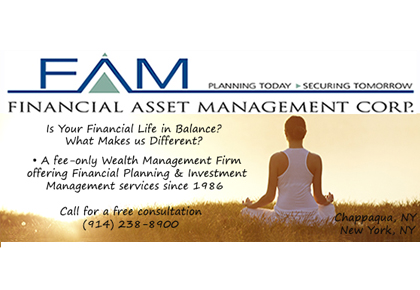Scott Kahan: Discusses the Interest Rate Cliff

Scott Kahan: Discusses The Interest Rate Cliff: As the heated rhetoric of Recession subsides, Scott Kahan, Certified Financial Planner ™ professional and President of Financial Asset Management Corp. in Chappaqua and NYC, discusses the interest rate cliff.
What happened to all the Recession Talk?
 The MIT Professor Paul Samuelson once quipped “the stock market has predicted nine of the last five recessions.” He said that in 1982 and the updated score is now 13 out of the last seven. The same goes for the talking heads you see on TV. Most of whom have gotten almost everything wrong for years. Yet the same networks bring them back to soberly predict the next turn in the road – as if there are no rear view mirrors in their minds. And that goes for some of the biggest names at some of the biggest banks.
The MIT Professor Paul Samuelson once quipped “the stock market has predicted nine of the last five recessions.” He said that in 1982 and the updated score is now 13 out of the last seven. The same goes for the talking heads you see on TV. Most of whom have gotten almost everything wrong for years. Yet the same networks bring them back to soberly predict the next turn in the road – as if there are no rear view mirrors in their minds. And that goes for some of the biggest names at some of the biggest banks.
The Recession Watch has been on throughout 2023 and as we have discussed in the past there were no signs of recession in the economy. So, don’t listen to the talking heads and stick to your models.
Why does the market over predict Recessions?
Because there’s always a recession ahead. Recessions are inevitable. The problem is we just don’t know when they are going to happen. It’s understandable that we had a recession watch while the Federal Reserve was aggressively raising rates to combat an inflation that reach 8% in 2022. Recessions often follow rate hikes as it famously did in 1980-82 when Paul Volcker raised rates to 20%.
What was different this time?
This time the labor market remained strong, and the consumer remained strong because of the unusual conflation of events during COVID that resulted in more money in consumer’s pockets, whether from Government stimulus, or cost savings for commuting office workers, and supply chain disruptions that resulted in more money chasing fewer goods.
And now?
 And now we have topping interest rates, the labor market and consumers remain resilient, and we are also seeing strong wage growth. With the Fed primed to make three rate cuts in 2024 – investment gurus are talking down recession and suggesting that a soft landing is on the way.
And now we have topping interest rates, the labor market and consumers remain resilient, and we are also seeing strong wage growth. With the Fed primed to make three rate cuts in 2024 – investment gurus are talking down recession and suggesting that a soft landing is on the way.
Is this just their latest wrong call?
Maybe, but barring black swan events or unforeseen miscalculations by our central bankers, they are now focusing on the underlying strengths of the economy that they seemed to ignore in the past. And that we have discussed in our past investment chats.
But why do polls show that Americans are so pessimistic about the economy?
The problem is that while inflation is decreasing that doesn’t mean prices are falling and the average person filling their cars at the gas station, or their grocery carts still see high prices. But prices don’t drop because inflation drops. Prices drop when we have deflation which we don’t have and that no one is predicting.
This round of inflation and interest rate hikes have been confusing for home buyers too…
 We mustn’t forget that what we are seeing is a normalization of interest rates after an extended period of near zero rates following the Great Recession of 2008. Compared to recent history, current interest rates are higher but much closer to historical averages. And while they will drop, people who are waiting for mortgage rates – that peaked at 8% last November and are down to the 7% range – to return to 2.5% may have a very long wait.
We mustn’t forget that what we are seeing is a normalization of interest rates after an extended period of near zero rates following the Great Recession of 2008. Compared to recent history, current interest rates are higher but much closer to historical averages. And while they will drop, people who are waiting for mortgage rates – that peaked at 8% last November and are down to the 7% range – to return to 2.5% may have a very long wait.
They are more likely to return to their historical average in the 6 to 7% range. Meanwhile, I might add, you have a lot of people who refinanced sitting on fixed rate mortgages in the 2’s and 3’s which is why there are so few houses on the market.
Although falling interest rates are good…
Falling interest rates usually help the underlying economy because businesses can borrow at lower rates and invest to grow their businesses and create jobs. This, in turn, helps the stock market. Falling interest rates are good for bond holders too, because bond prices rise when interest rate falls.
Beware the interest rate cliff…
The problem the interest rate cliff holds is for people who have stashed their funds in high interest savings accounts and CDs. Spooked by the difficult year 2022 when both the stock and bond markets fell, some bond holders bailed out and grabbed the sure thing savings and CD rates that are as high as 5.5%. Now those rates are geared to fall if Fed Chair Powell follows through on his stated plan to drop rates three times in 2024. This will cause both stocks and bonds to rise and now these savers will be chasing rising prices for all asset classes.
 Last year we reallocated our models away from short term bond funds and ETF’s where we were for years and moved to intermediate term bond funds. Maturities with 5-10 years. This asset class is primed for price appreciating in the next couple of years – as well as offering current yields in the upper three to four and a half percent range.
Last year we reallocated our models away from short term bond funds and ETF’s where we were for years and moved to intermediate term bond funds. Maturities with 5-10 years. This asset class is primed for price appreciating in the next couple of years – as well as offering current yields in the upper three to four and a half percent range.
So, it’s not even safe to chase safety…
It may feel good now but you’re still reacting to the market instead of sticking with your models. Which, as we have discussed, after allowing for your cash slush funds to cover six-months to a year of expenses, most advisors recommend a 60/40, stock/bond portfolio. As we do.
When we trade, it’s not due to headline grabbers stumping for their firms on TV or internet click bait but because one asset class appreciated over the other and our allocations need to be reset back to 60/40. If you let your model be your guide, you won’t let any big bank celebrities – who are heralded as market sages on TV but make bad calls often – give you a bum steer.
Financial Asset Management Corporation has provided fee-only financial planning and investment management services for individuals and small businesses in the Tri-State area since 1986. They serve 175 clients and manage over 325 million dollars in assets. (26 South Greeley Avenue, Chappaqua, NY, (914) 238-8900; www.famcorporation.com )
More on What To Do from Scott Kahan here:

















